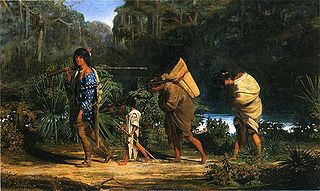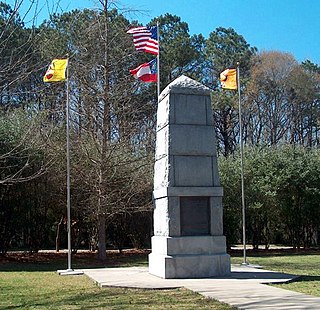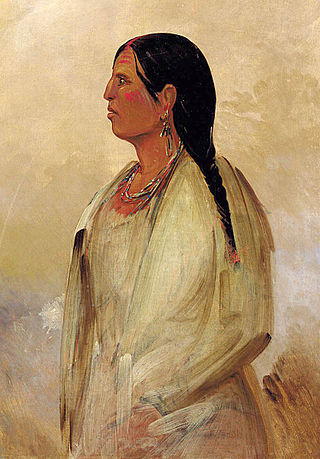Related Research Articles

The Choctaw are a Native American people originally based in the Southeastern Woodlands, in what is now Alabama and Mississippi. Their Choctaw language is a Western Muskogean language. Today, Choctaw people are enrolled in three federally recognized tribes: the Choctaw Nation of Oklahoma, Mississippi Band of Choctaw Indians, and Jena Band of Choctaw Indians in Louisiana.

The Trail of Tears was an ethnic cleansing and forced displacement of approximately 60,000 people of the "Five Civilized Tribes" between 1830 and 1850 by the United States government. As part of the Indian removal, members of the Cherokee, Muscogee (Creek), Seminole, Chickasaw, and Choctaw nations were forcibly removed from their ancestral homelands in the Southeastern United States to newly designated Indian Territory west of the Mississippi River after the passage of the Indian Removal Act in 1830. The Cherokee removal in 1838 was brought on by the discovery of gold near Dahlonega, Georgia, in 1828, resulting in the Georgia Gold Rush.

The Chickasaw are an Indigenous people of the Southeastern Woodlands, United States. Their traditional territory was in northern Mississippi, northwestern and northern Alabama, western Tennessee and southwestern Kentucky. Their language is classified as a member of the Muskogean language family. In the present day, they are organized as the federally recognized Chickasaw Nation.

The term Five Civilized Tribes was applied by European Americans in the colonial and early federal period in the history of the United States to the five major Native American nations in the Southeast, the Cherokee, Chickasaw, Choctaw, Muscogee, and Seminoles. Americans of European descent classified them as "civilized" because they had adopted attributes of the Anglo-American culture.

The Bureau of Indian Affairs (BIA), also known as Indian Affairs (IA), is a United States federal agency within the Department of the Interior. It is responsible for implementing federal laws and policies related to Native Americans and Alaska Natives, and administering and managing over 55,700,000 acres (225,000 km2) of reservations held in trust by the U.S. federal government for indigenous tribes. It renders services to roughly 2 million indigenous Americans across 574 federally recognized tribes. The BIA is governed by a director and overseen by the Assistant Secretary for Indian Affairs, who answers to the Secretary of the Interior.

The Houma are a historic Native American people of Louisiana on the east side of the Red River of the South. Their descendants, the Houma people or the United Houma Nation, have been recognized by the state as a tribe since 1972, but are not recognized by the federal government.

Indigenous peoples of the Southeastern Woodlands, Southeastern cultures, or Southeast Indians are an ethnographic classification for Native Americans who have traditionally inhabited the area now part of the Southeastern United States and the northeastern border of Mexico, that share common cultural traits. This classification is a part of the Eastern Woodlands. The concept of a southeastern cultural region was developed by anthropologists, beginning with Otis Mason and Franz Boas in 1887. The boundaries of the region are defined more by shared cultural traits than by geographic distinctions. Because the cultures gradually instead of abruptly shift into Plains, Prairie, or Northeastern Woodlands cultures, scholars do not always agree on the exact limits of the Southeastern Woodland culture region. Shawnee, Powhatan, Waco, Tawakoni, Tonkawa, Karankawa, Quapaw, and Mosopelea are usually seen as marginally southeastern and their traditional lands represent the borders of the cultural region.
State-recognized tribes in the United States are organizations that identify as Native American tribes or heritage groups that do not meet the criteria for federally recognized Indian tribes but have been recognized by a process established under assorted state government laws for varying purposes or by governor's executive orders. State recognition does not dictate whether or not they are recognized as Native American tribes by continually existing tribal nations.

The Choctaw Nation of Oklahoma is a Native American territory covering about 6,952,960 acres, occupying portions of southeastern Oklahoma in the United States. The Choctaw Nation is the third-largest federally recognized tribe in the United States and the second-largest Indian reservation in area after the Navajo. As of 2011, the tribe has 223,279 enrolled members, of whom 84,670 live within the state of Oklahoma and 41,616 live within the Choctaw Nation's jurisdiction. A total of 233,126 people live within these boundaries, with its tribal jurisdictional area comprising 10.5 counties in the state, with the seat of government being located in Durant, Oklahoma. It shares borders with the reservations of the Chickasaw, Muscogee, and Cherokee, as well as the U.S. states of Texas and Arkansas. By area, the Choctaw Nation is larger than eight U.S. states.
The Mississippi Band of Choctaw Indians is one of three federally recognized tribes of Choctaw people, and the only one in the state of Mississippi. On April 20, 1945, this tribe organized under the Indian Reorganization Act of 1934. Their reservation included lands in Neshoba, Leake, Newton, Scott, Jones, Attala, Kemper, and Winston counties. The Mississippi Choctaw regained stewardship of their mother mound, Nanih Waiya mounds and cave in 2008. The Mississippi Band of Choctaw have declared August 18 as a tribal holiday to celebrate their regaining control of the sacred site. The other two Choctaw groups are the Choctaw Nation of Oklahoma, the third largest tribe in the United States, and the Jena Band of Choctaw Indians, located in Louisiana.
Indian termination is a phrase describing United States policies relating to Native Americans from the mid-1940s to the mid-1960s. It was shaped by a series of laws and practices with the intent of assimilating Native Americans into mainstream American society. Cultural assimilation of Native Americans was not new; the belief that indigenous people should abandon their traditional lives and become what the government considers "civilized" had been the basis of policy for centuries. What was new, however, was the sense of urgency that, with or without consent, tribes must be terminated and begin to live "as Americans." To that end, Congress set about ending the special relationship between tribes and the federal government.
Federal Indian policy establishes the relationship between the United States Government and the Indian Tribes within its borders. The Constitution gives the federal government primary responsibility for dealing with tribes. Some scholars divide the federal policy toward Indians in six phases: coexistence (1789–1828), removal and reservations (1829–1886), assimilation (1887–1932), reorganization (1932–1945), termination (1946–1960), and self-determination (1961–1985).

Native American recognition in the United States, for tribes, usually means being recognized by the United States federal government as a community of Indigenous people that has been in continual existence since prior to European contact, and which has a sovereign, government-to-government relationship with the Federal government of the United States. In the United States, the Native American tribe is a fundamental unit of sovereign tribal government. This recognition comes with various rights and responsibilities. The United States recognizes the right of these tribes to self-government and supports their tribal sovereignty and self-determination. These tribes possess the right to establish the legal requirements for membership. They may form their own government, enforce laws, tax, license and regulate activities, zone, and exclude people from tribal territories. Limitations on tribal powers of self-government include the same limitations applicable to states; for example, neither tribes nor states have the power to make war, engage in foreign relations, or coin money.
The MOWA Band of Choctaw Indians is a state-recognized tribe, located in southwest Alabama, with a population largely based in southern Washington County and some membership in northern Mobile County.

The Jena Band of Choctaw Indians are one of three federally recognized Choctaw tribes in the United States. They are based in La Salle, Catahoula, and Grant parishes in the U.S. state of Louisiana. The Jena Band received federal recognition in 1995 and has a reservation in Grant Parish. Their headquarters are at Jena, Louisiana. Tribal membership totals 327.

The Choctaw Trail of Tears was the attempted ethnic cleansing and relocation by the United States government of the Choctaw Nation from their country, referred to now as the Deep South, to lands west of the Mississippi River in Indian Territory in the 1830s by the United States government. A Choctaw Miko (chief) was quoted by the Arkansas Gazette as saying that the removal was a "trail of tears and death." Since removal, the Choctaw have developed since the 20th century as three federally recognized tribes: the largest, the Choctaw Nation of Oklahoma; the Mississippi Band of Choctaw Indians, and the Jena Band of Choctaw Indians in Louisiana.
United States v. John, 437 U.S. 634 (1978), was a case in which the Supreme Court of the United States held that lands designated as a reservation in Mississippi are "Indian country" as defined by statute, although the reservation was established nearly a century after Indian removal and related treaties. The court ruled that, under the Major Crimes Act, the State has no jurisdiction to try a Native American for crimes covered by that act that occurred on reservation land.

Harry James Watson "Jimmy" Belvin was an educator and served as an Oklahoma State Representative and Senator. He was the first elected principal chief of any of the Five Civilized Tribes in the 20th century, and the longest serving principal chief of the Choctaw Nation of Oklahoma. He saw his tribe through termination, restoration, and a rebirth of Native Pride. He was a polarizing leader, seen by some as a semi-dictator who held onto the office of principal chief and used his power to advocate for complete assimilation into the dominant society, suppressing Choctaw traditions, language and ceremonial practices as undesirable remnants of an unrefined history. To others, he was a well-liked, populist leader, who went door-to-door talking with tribe members, informing them on issues, and trying to develop the means the alleviate the poverty and unemployment they faced.
The History of the Choctaws, or Chahtas, are a Native American people originally from the Southeast of what is currently known as the United States. They are known for their rapid post-colonial adoption of a written language, transitioning to yeoman farming methods, and having European-American and African-Americans lifestyles enforced in their society.
References
- 1 2 3 Brescia, William (Bill) (1982). "Chapter 3, Treaties and the Choctaw People". Tribal Government, A New Era. Philadelphia, Mississippi: Choctaw Heritage Press. pp. 21–22.
- ↑ McKee, Jesse O. (2008). The Choctaws: Cultural Evolution of a Native American Tribe. University Press of Mississippi. p. 158. ISBN 978-1-60473-170-5.
- ↑ Lowery, Malinda Maynor (2010). Lumbee Indians in the Jim Crow South: race, identity, and the making of a nation. Chapel Hill, North Carolina: University of North Carolina Press. p. 130. ISBN 978-0-8078-7111-9.
- ↑ Osborne, Katherine, M.B. "In the Name of Justice and Fairness:The Mississippi Choctaw Indian Federation vs. the BIA, 1934", in Cobb, Daniel M.,Beyond Red Power:American Indian Politics and Activism Since 1900, 2007, School for Advanced Research Press, Santa Fe, New Mexico, ISBN 978-1-930618-86-2
- 1 2 "Mississippi Band of Choctaw Indians". Choctaw Chronology: Part V. Mississippi Band of Choctaw Indians . Retrieved 2 August 2011.
- ↑ Hearings on H. R. 7902. Washington, D.C.: United States Congress House Committee on Indian affairs. 1934. p. 373.